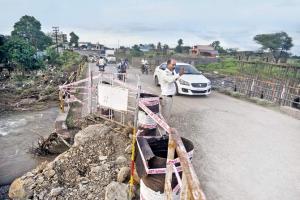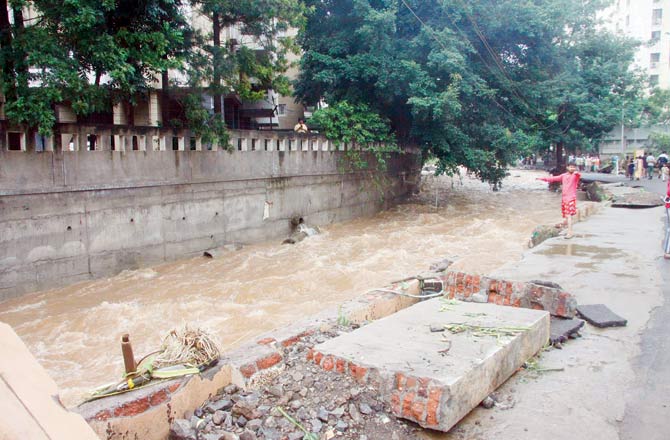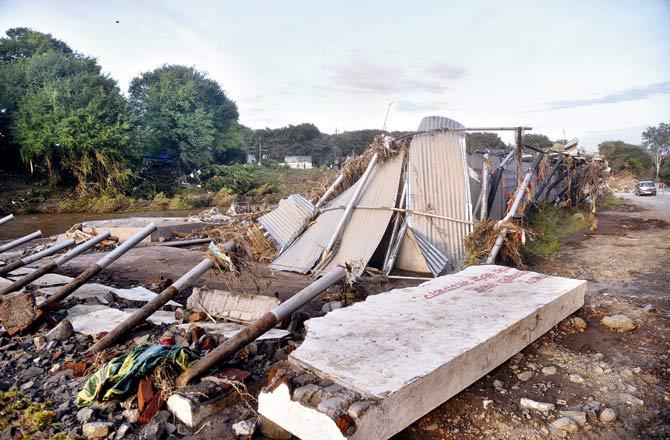Exclusive: Shocked at the unprecedented devastation that last week's deluge caused in Pune? You shouldn't be. As satellite city endures real estate boom mirroring Mumbai, activists say 2014 TERI report spoke of higher temperatures, heavier rain

The violent Karha river in Saswad, 40 kms from Pune, destroyed the bridge than runs over it. Pic/Pradeep Dhivar
A warning had come to the Maharashtra government that Pune would be prone to floods as early as 2014. Of course, in the manner of most things government, the warning was ignored. Result? Severe rainfall this week has left 22 people in Pune city dead and four missing. Rainfall of 106 mm fell in the city over only two days last week—Tuesday and Wednesday. Yet, 16,000 people had to be evacuated to safety from not just Pune City, but areas like Baramati, Bhor, Purandhar, Saswad and Khed-Shivapur.
ADVERTISEMENT
All this could have been avoided, says Sarang Yadwadkar had the state government paid heed to the report that had been kept on its desk by the The Energy and Resources Institute (TERI), a Delhi-based research institute that specialises in the fields of energy, environment and sustainable development.

Ambil Odha floods housing localities in Sahkar Nagar, Pune. Pic/Mandar Tannu
Yadwadkar says that the 2014 report commissioned by the government, interestingly, studied the impact of climate change across Maharashtra. And the report said that several areas would receive 37.5 per cent more rain in fewer days due to climate change. Yet, no action was taken. Even measures suggested by the report to mitigate the effects of climate change and the rapid urban development faced by the city, were not acted upon.
TERI was appointed to conduct a nation-wide study after the central government gave instructions to study the effects of climate change in 2009. It's 2014 report to the Maharashtra state government, clearly indicated increased occurrence of cloudbursts along with higher annual average rainfall. Yadwadkar says that the report also specified that in the coming decades annual rainfall would increase by almost 37.5 per cent. As a precautionary measure, the stormwater drainage capacity of Pune should have been increased. However, the authorities have failed to do this, Yadwadkar says.

Sites of destruction due to the rain are common around Pune. This is a shed near Karhar river
Titled Assessing Climate Change Vulnerability and Adaptation Strategies for Maharashtra: Maharashtra State Adaptation Action Plan on Climate Change (MSAAPC), the TERI report (a copy of which is with mid-day) stated that while the IMD states that the annual mean temperature in Pune is 25.22ºCelsius, due to climate change the temperature would rise by 1.15 – 1.28ºC by 2030.
The report also states that the city's average rainfall of 852.2 mm, will see an increase of between 10 mm to 32.5 mm by 2030. In order to prevent flood-like situation and preserve the biodiversity, the report states, "Enhance tree cover in cities with high growth in peri-urban areas like Pune."
The 2014 TERI report had warned against the increasing growth rate in Pune and Thane. "Thane and Pune have registered high growth rates (35.9% and 30.3 % respectively) in the last decade. The current growth rate has increased the population density of the State to around 365 persons per sq. km as compared to 315 in 2001." The report which discusses the impacts of climate change on agriculture, livelihoods and how to mitigate these affects also discusses predicted rise in demands for better cooling systems and calls for promotion of solar-powered systems and green roofs.
A river obstructed
What was once the Pensioner's Paradise, has in the last decade, become a bustling satellite city to Mumbai thanks to the IT hub that has made home here. While the economy of the city has for sure been given a boost, the other industry that has seen a rise is Pune, is the real-estate business with demands for homes increasing. This, say, environmentalists, has meant increased encroachment along river banks.
Yadwadkar points to the rampant encroachment along Ambil Odha, which originates from the Sahyadris, near Purandhar Fort. He says that had Ambil Odha been identified as a river instead of a natural water stream in the Pune Municipal development plan—as demanded by the green activists for the last two years—the development boundaries could have been easily drawn. But in this case, construction nears the edge, thus narrowing its water carrying capacity and endangering those living alongside it.
Sewage and drainage lines passing through the stream, thus blocking it further. Another issue is the second stream that originates from the basin of Katraj hill. This one is encumbered by excavation projects and cutting of trees, which increased the force with which the water flows.
"Even water bodies have a temperament, which should not be disturbed," said Yadwadkar. Pune's Guardian Minister Chandrakant Patil admitted to the issue a few days ago, saying it's not just Ambil Odha, but the problem of encroachment along water bodies is rampant across the city. While an investigation is needed, he said, it would now have to be done post the assembly elections as a code of conduct was in place. On TERI's report, PMC Commissioner Saurabh Rao said, "Neither I nor any department of PMC has got any such report." When asked about encroachment along with water bodies, he refused to comment.
10-32.5mm
Increased rainfall predicted by 2030 in report
37.5
The percentage increase of rainfall Pune is likely to see by 2030
Catch up on all the latest Crime, National, International and Hatke news here. Also download the new mid-day Android and iOS apps to get latest updates
 Subscribe today by clicking the link and stay updated with the latest news!" Click here!
Subscribe today by clicking the link and stay updated with the latest news!" Click here!






